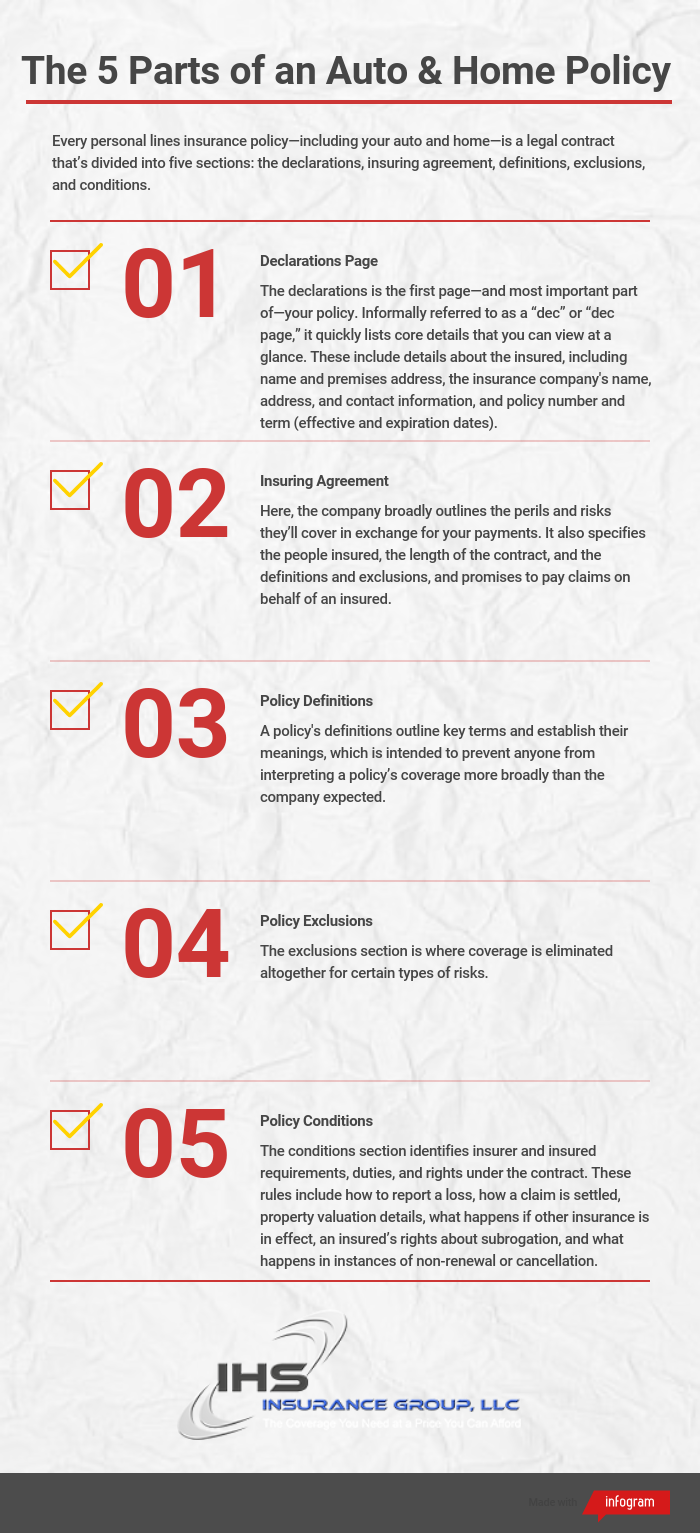
Why Should You Understand Your Auto & Home Policy Sections?
Every personal lines insurance policy—including your auto and home—is a legal contract that’s divided into five sections: the declarations, insuring agreement, definitions, exclusions, and conditions.
Together, these sections outline the specific coverage your policy does—and perhaps more importantly, does not—provide. It also conveys your rights and obligations as an insured before, during, and after a claim.
Given this importance, it’s a good idea as a policyholder to have a high-level understanding of each section, which is precisely what this article provides. Let’s start from square one.
What is a Policy Declarations Page?
The declarations is the first page—and most important part of—your policy. Informally referred to as a “dec” or “dec page,” it quickly lists core details that you can view at a glance, such as:
- Details about the insured, including name and premises address
- Insurance company name, address, and contact information
- Policy number and term (effective and expiration dates)
- Coverage limits, including deductible and endorsements
- Lenders and other loss payees, when applicable
- Details about the covered property, whether a house, vehicle, watercraft, etc.
- How much you pay for each coverage
As you might guess, the exact information contained on a declarations page will depend on factors like the type of policy (e.g., home vs. auto), the location, coverage limits, and so forth.
Because of its importance, insurance carriers will send you updated policy paperwork—including dec pages—any time a change is made, or a renewal arrives.
How Does Your Auto & Home Insuring Agreement Work?
In your policy’s insuring agreement, the company broadly outlines the perils and risks they’ll cover in exchange for your payments. It also specifies the people insured, the length of the contract, and the definitions and exclusions, and promises to pay claims on behalf of an insured.
Despite this promise, the purpose of an insuring agreement is to clearly convey whether or not a loss is covered. If the insured disagrees with the company’s interpretation of the insuring agreement’s language, lawsuits can occur.
What Important Information Does Your Policy’s Definitions Contain?
Whereas your policy’s insuring agreement broadly defines coverage, its definitions, and exclusions (more next) narrow coverage.
Specifically, these definitions outline key terms and establish their meanings, which is intended to prevent anyone from interpreting a policy’s coverage more broadly than the company expected.
Why is this necessary? Because insurance terminology doesn’t always align with common usage.
A couple of quick examples: Under an auto policy, an insurance company defines a car differently than it does a watercraft. The purpose is to delineate that an automobile is covered, while a vehicle that drives on the water is not–even though they both have steering wheels.
Furthermore, in the real world, a schedule references a plan for your time. But in the context of personal lines insurance, a schedule is a list of changes that alter coverage on your policy (e.g., scheduling specific fine arts or jewelry pieces).
In other parts of the policy, carriers will typically feature quotation marks around special terms included in the definitions section.
What Should You Know About the Exclusions Section?
We’ve learned that a policy’s insuring agreement broadly defines coverage and that the definitions narrow coverage. Now, the exclusions section is where coverage is eliminated altogether for certain types of risks.
As such, it’s vital that you carefully read through your exclusions and discuss them with your agent if additional clarification is needed.
Pro tip: Although it’s easy to think otherwise, a policy’s exclusions section doesn’t necessarily contain an exhaustive list. You might also locate coverage exclusions in other sections, including the conditions (more next), definitions, endorsements, and insuring agreement.
What is in the Conditions Section of an Insurance Policy?
While the previous three sections pertain to the scope of coverage provided under a personal lines insurance policy, its conditions section identifies insurer and insured requirements, duties, and rights under the contract.
A simple way to think of the conditions is as the “rules” of the policy. And if these conditions or rules aren’t met, the carrier can deny a claim.
These rules include how to report a loss, how a claim is settled, property valuation details, what happens if other insurance is in effect, an insured’s rights about subrogation, and what happens in instances of non-renewal or cancellation.
Examples of requirements listed in the conditions:
- File a proof of loss with the company
- Protect property after a loss
- Cooperate during the company’s investigation
Alright! We’ve covered a lot of information in a relatively short time here, so let’s go ahead and wrap up and help you decide what you should do next.
Do You Have Additional Questions About Home & Auto Policy Sections?
The reality is that insurance, whether related to personal lines, business, commercial, or any other type, isn’t always consumer-friendly since a lot of confusing wording and unfamiliar terms are frequently thrown around.
And while you could technically find some clarification in the five different sections discussed above, it’s always handy to have an IHS Insurance Group professional by your side to answer questions and guide your choices.
Need a FREE Quote or have questions regarding Automobile Insurance Coverage? We have two convenient ways to reach us:
- If you prefer to talk to a licensed agent directly, please call (866) 480 5063.
- If you prefer to fill out a quick form and have an agent get back with you at your convenience, use the GET A FREE QUOTE.
- Lastly, for those that want an immediate quote, please click HERE.
We look forward to speaking with you today!

